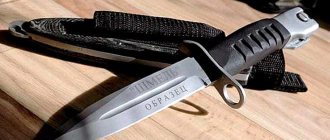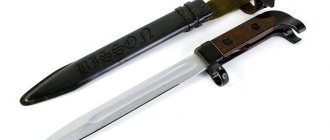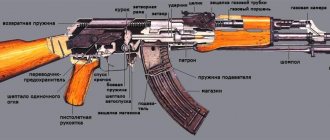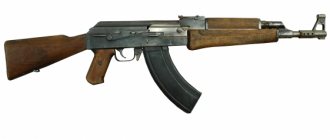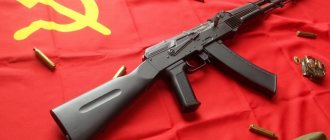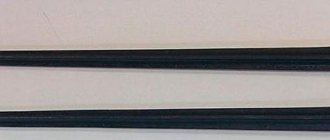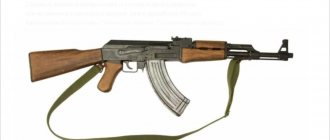Needle bayonets
At the end of the XVII-XVIII centuries. a new revolution took place in military affairs, and mounts completely fell out of use. This is due to the appearance of needle bayonets, which were triangular or T-shaped in cross-section. And they were located with the flat side parallel to the trunk. This decision was due to the fact that the firearm was loaded from the side of the barrel, and if there was a sharp cutting edge located close to the barrel, the fighter could easily injure his hand.
Due to the fact that the bayonet was a simple needle, with a round base tube, it was fashionable to fully use the weapon, both for shooting and in hand-to-hand combat. Which of course increased the effectiveness of the battle.
Historical reference
A bayonet (German Stick - “edge, piercing blow, injection”) is a bladed weapon. It is attached to the barrel of a gun, rifle, carbine, or machine gun. This makes it possible to use it as a spear or pike in close hand-to-hand combat.
The item appeared in 1647 in France. Then it was called a bayonet (baguinet), after the city of Bayonne, the place of invention. The weapon looked like a dagger inserted inside the barrel of a musket.
In 1694, Germany began producing an all-metal bayonet equipped with a tube on the pommel. He was mounted on the narrow muzzle of a gun, which had replaced a wide-barreled and heavy musket. This made it possible to load the weapon and fire it with the blade attached.
In Russia, bayonets appeared in 1702, under Peter the Great. From then until World War II, they were the main tool in hand-to-hand infantry attacks. Now the bayonet has an auxiliary function or, as the military says: “it is a weapon of last chance.”
According to the shape of the blade, they are divided into:
- needle-shaped: rounded, three- (Russian) and tetrahedral;
- bladed.
Depending on the type of fixation, weapons can be removable or non-removable.
Blade blades are divided into three subtypes: without a handle, a cleaver and a bayonet-knife. The latter looks like a flat blade with a handle, sleeve or cross-ring for attachment to the barrel. In some cases, there is a sawtooth sharpening on the butt. Worn on a waist belt, in a case.
Advantages:
- Versatility. In its attached form, unlike its needle counterpart, it causes both puncture and incised wounds. Separately used as a combat knife.
- Reliability. Increases the soldier's readiness (when ammo is used up) to give close combat, without the risk of losing his weapon.
- Multifunctionality. After removal, it is used as a combat or household knife; it can also be used to dig in, chop and saw branches. When connected to the scabbard, it turns into wire cutters.
The famous bayonet for the Mosin rifle
The first bayonets for the Mosin rifle appeared before the start of the First World War. If you look up the archival documents of those years, you can see that initially it was proposed to make the Mosin bayonet a knife type. However, supporters of classic needle weapons managed to insist on the old design. Mosin rifles continued to be produced in the USSR after the Civil War, with several bayonet upgrades.
It should be noted that in the USSR they mainly modernized the bayonet mount, leaving its shape unchanged. During the Great Patriotic War, bayonets with knife or even dagger blades appeared, but these were homemade.
The evolution of the Soviet bayonet
In 1955, a bayonet knife was adopted for service, intended to equip the Kalashnikov assault rifle under the symbol GRAU 6X2. The blade was identical in shape to the bayonet-knife from the SKS carbine, but shorter. The handle linings were made of dark cherry-colored volknit. Only machine guns with a non-folding butt were equipped with these kind of knives. Production ceased in 1960.
In 1960, a new model was put into service, which was produced for 4 years, under the symbol GRAU 6x3. An oval hole was made on the blade, with which it was possible to cut through the wire by attaching a sheath. On the side of the butt a saw was made for working on wood and steel. The bayonet was installed only on AKM assault rifles. Installation on AK74 and AKS74 is impossible due to the shape of the handle. The sheath is made of stainless steel.
In 1965, a bayonet model with the GRAU 6x4 index was adopted, which was produced until 1985. The blade retained its 6x3 shape, and the handle was now made in the form of a single piece from the AG-4B press material. The blade shank was fixed with glue.
In 1985, a bayonet with the GRAU 6X5 index was adopted, which was completely different from previous generations of knives. The blade became spear-shaped, which improved penetrating properties; the shank of the click was filled with polyamide in the handle, forming a non-separable structure.
Specialization... bayonets
The 8th Danish Brigade goes on the attack at Dubbel. Wilhelm Rosenstand (1838-1915). National History Museum, Copenhagen
And the mighty Karl, angry, sees no longer the upset clouds of the unfortunate Narva fugitives, but a thread of brilliant, slender regiments, obedient, fast and calm, and a row of unshakable bayonets.
(Poltava A.S. Pushkin) History of weapons.
With the advent of rapid-firing percussion rifles, and then cartridge-based repeating rifles, huntsmen ceased to exist as a branch of infantry. The last time they fought in a uniform that differed from the general army uniform was during the American Civil War. These were the “Berdan shooters,” but their debut, although impressive, remained in history as “the last chord in the old play about the huntsmen.” Already in the Russian-Turkish War of 1877-1878. The use of American Winchesters by the Turks in the battle near Plevna did not allow our infantry to approach the Turkish trenches and bring the matter to a blow with bayonets. Well, with the discovery of smokeless gunpowder, there was no longer any hope that infantry in line formation would launch bayonet attacks. Nevertheless, the inertia of thinking of various military authorities was so great that their opinion was “the bullet is stupid - the bayonet is great,” “shoot rarely, but shoot accurately!” remained dominant for a long time. The inconsistency of these judgments, however, was already shown by the battles of the Austro-Danish-Prussian (Danish-German) and Franco-Prussian wars, which cost huge losses in the infantry of supporters of the previous military tactics. But they still used single-shot rifles that fired black powder cartridges! By the way, the same counterattacks on the Prussian regiments at the Battle of Dubbel only led to huge losses, as they were met with fire from rapid-fire needle rifles. What then could be expected from future wars, in which soldiers would fight with repeating rifles in their hands, and smokeless gunpowder would be used in the cartridges?!
Prussian soldiers attack the Danes at the Battle of Dubbel. Richard Knotel (1857-1914)
No one disputed the advantages of needle bayonets, but in addition to them, a cleaver was also required. And in the new conditions, when almost hundreds of cartridges were shot during the battle, carrying both a cleaver and a bayonet seemed to many to be too... irrational. The time when a soldier would shoot, God forbid, a dozen rounds of ammunition throughout the entire battle, is now over. They tried to reduce the loadout, saving literally on grams, just to give the soldier more ammunition, so the idea of a universal bayonet gradually became actualized in the minds of even the most traditionally thinking generals. Although not immediately and not everywhere...
The simplest mounting of a blade bayonet was carried out on a Baker rifle. On the right side of the barrel (on the right, because there was a ramrod at the bottom!) there was an L-shaped stand (very clearly visible in the photo), which fit into the groove of the handle and was secured with a spring latch. In this case, the handle and blade were located horizontally on the right. This slightly shifted the balance of the gun, but the blade fit well into the body between the ribs. A still from one of the films in the series about the adventures of the royal marksman Sharpe
Thus, in England, the blade bayonet was introduced in 1854 and even managed to take part in the battles of Alma and Inkerman during the Crimean War. The bladed bayonet also appeared on the French Chassepot rifle (see previous material - V.O.), as well as in the armies of a number of other countries.
As one British newspaper wrote,
The committee, in recommending this new bayonet, apparently had in mind the fact that henceforth bayonets would be less often used as weapons of attack and defense than in former times; so they wanted to replace the old bayonet with a more general purpose tool.
English cavalry carbine bayonet, Model 1835. Royal Arsenal, Leeds
English fittings and bayonets for them (1841). Royal Arsenal, Leeds
Already for the Martini-Henry rifle of the 1871 model, a machete bayonet with a blade flaring towards the end and a sawtooth back is accepted. It proved to be a very effective cutting weapon, but was produced only in small quantities, since it turned out to be much more expensive than the classic stabbing bayonet.
Traditional needle bayonet of the Martini-Henry rifle, 1877-1899. Royal Arsenal, Leeds
Then, already in 1875, a saw bayonet was adopted for the Snyder rifle (artillery carbine) as the most convenient for artillerymen, as well as sappers and... army butchers, since with its help it was possible... to butcher cattle for meat!
French needle bayonet from the early 19th century. with fastening ring (photo by Alain Daubresse)
The German states adopted the first such bayonet in 1865; until the middle of the First World War, approximately 5% of blade bayonets were supplemented with a saw variant. In Belgium, such bayonets appeared in 1868, in Great Britain the first models - in 1869, in Switzerland - in 1878 (the last model in 1914). The original "backsaw" bayonets were issued for sappers, and to some extent the bayonet aspect of them was secondary to the "tool" aspect. Later, German “saw bayonets” became more of an indicator of the rank of their owner than a functional saw. And it was not very convenient to saw with such bayonets. Therefore, in most countries by 1900, sawtooth bayonets were abandoned. The German army stopped using the backsaw bayonet in 1917, only after international protests that the serrated blade caused unnecessarily serious wounds when used as a fixed bayonet.
Nevertheless, double-edged blade knives were used very widely. These were: the British Mk2 bayonet of 1888 for the Lee-Metford rifle (the first knife bayonet adopted by the army of the United Kingdom), the British long bladed bayonet with a hook bow (disappeared after 1913) of 1907 for the “short” rifles" "Lee-Enfield" and even... a ceremonial bayonet of the German Nazi police in 1940. The latter had neither a groove on the handle nor a latch, that is, it was simply impossible to attach it to the rifle, but it had a beautiful eagle head on the handle, and the handle itself was decorated with deer antler overlays!
British bladed bayonet, 597 mm long, model 1875. Designed for artillerymen armed with a rifle (Snyder carbine), type 1. Photo by Auckland Institute and Museum, New Zealand
Since 1870, the US Army has been producing shovel bayonets for infantry regiments according to the design of Lieutenant Colonel Edmund Rice, and such bayonets could not only pierce and be used as an earth-moving tool, but also be used... instead of a spatula for plastering walls; and sharpened on one side, it could cut sticks and pegs for setting up a tent. True, in 1881 the US Army declared this “spatula bayonet” obsolete.
American "spatula bayonet" 1871-1899. Royal Arsenal, Leeds
From 1899 to 1945, the Japanese used a very long (25.4 cm) bayonet with a "Type 30" blade on the already very long Arisaka rifle. Obviously, this was done to compensate for the height and relatively short arm length of the infantrymen of the Japanese army.
Comblain's Brazilian carbine. Official name: Model 4 Artillery and Engineer Carbine, Model 1892 A total of 3,000 were produced at the Nagana plant in Liege. Caliber 11 mm. Brazilian bayonet, model 1888 (photo by Alain Daubresse)
Close-up of the same bayonet. A typical scimitar bayonet! Reverse curvature blade, fuller, T-shaped profile with reinforced “back” (photo by Alain Daubresse)
The bayonet-sword (which had lost its bow with a hook) of the French Lebel rifle, which itself was also very long, was also very long. This prevented its use in the trenches with a fixed bayonet, but it helped in the desperate bayonet charges that French soldiers made at the very beginning of the First World War.
All-metal handle of a Comblain carbine bayonet with a cross-hook (photo by Alain Daubresse)
The French army received this bayonet in 1886, and its length was 52 cm, resulting in the total length of the rifle and bayonet being 1.8 m. In response, Germany adopted the Seitengewehr 98 bayonet with a length of 50 cm for the Mauser rifle of the 1898 model. the total length of the rifle with a bayonet was 1.75 m, that is, it was quite a bit inferior to the French one.
French infantry with Lebel rifles mod. 1886 learns to conduct a bayonet attack. Photo 1913
In 1905, the German army adopted the shortened 37 centimeter long Seitengewehr 98/06 bayonet for the engineering troops, and in 1908 also the short Karabiner Model 1898AZ rifle, which was produced in limited quantities for cavalry, artillery and other special forces. The long-barreled Mauser 98 rifle remained in service as the main infantry small arms. Moreover, the German military continued to do everything possible to promote the idea of defeating the enemy on the battlefield not only with fire, but also with bayonets. Training in bayonet techniques was equated with the ability to shoot accurately. An impressive bayonet training method was developed, which was later adopted by the armies of many other countries, including the US Army, where on the eve of the First World War a bladed bayonet 40.6 cm long was used with the Springfield rifle.
Bladed bayonet for the Winchester 1895 rifle. Rifles of this system were ordered by the Russian government in the USA during the First World War for the Russian Imperial Army (photo by Alain Daubresse)
Before the war, three types of blade bayonet mounts were created. The first is similar to the bayonet mount on the Baker rifle (side right). The second is for the Mauser M88 and M98 rifles with a bayonet mount under the barrel and a T-shaped slot for a pin in the handle. With a side fastening using a ring in the crosshairs, with which the bayonet handle was put on the barrel, while its pommel was secured to it using a T-shaped protrusion on the barrel and a corresponding profile groove in the handle. Finally, the fastening of the bayonet under the barrel is similar to the Enfield rifle of the 1914 model, when the bayonet is fastened under the barrel in the same way as the bayonet of the German Mauser, but also by the ring on the crosshair with an emphasis on the base of the front sight.
The Russian Imperial Army traditionally used tetrahedral needle bayonets, attached to the barrel using a coupling with an L-shaped groove. It was forbidden to remove them, since the rifle was sighted together with the bayonet. However, so that the bayonet would not interfere, it was often removed and put on again, with the tip facing towards you.
To be continued…
AKM bayonet and its modifications
The first Kalashnikov assault rifle, which entered service in 1949, was completely devoid of a bayonet. Only after modernization in 1953 did he finally acquire these archaic edged weapons. The bayonet was called 6X2 and almost completely copied the SVT-40 bayonet. The only difference was the locking mechanism.
The bayonet for the AKM was made on the basis of the Navy reconnaissance knife, which was designed by Lieutenant Colonel Todorov in 1956. For the AK-74, its own version of the bayonet, model 1978, was developed.
In 1989, another modernization of the AK bayonet took place, but the terrible quality of these bayonets made all the engineers’ efforts useless.
Currently, bayonets are living out their last days. According to military experts, they will soon disappear completely.
